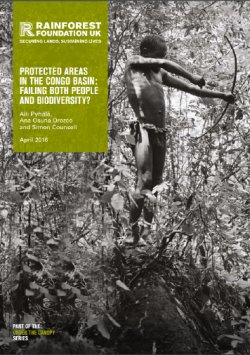 Hundreds of millions of dollars have been invested in the Congo Basin protected area network over recent decades. But where exactly has the money gone? What has it achieved? Who is it benefitting?
Hundreds of millions of dollars have been invested in the Congo Basin protected area network over recent decades. But where exactly has the money gone? What has it achieved? Who is it benefitting?
Background
The Rainforest Foundation UK’s extensive research into a set of protected areas across Cameroon, Gabon, the Republic of Congo, the Central African Republic and the Democratic Republic of Congo strongly suggests that conservation efforts have done little to save important rainforest species. Meanwhile, indigenous and local communities continue to pay a heavy price for protected areas that are often imposed on their ancestral lands without their consent.
Forest dwellers in the world’s second largest rainforest very often associate the presence of protected areas with increased hardships and see it as a source of conflict. Restrictions to access and use of lands for hunting, gathering and agriculture put severe strains on local communities’ meagre livelihoods. Reports of gross human rights violations at the hands of ‘eco-guards’ are also ubiquitous.
Alienating and victimising the very people who have protected these forests for centuries is clearly an unsustainable approach.
This situation has been allowed to develop partly because of a lack of publicly available information on conservation funding and practices. This lack of transparency makes it difficult to assess and scrutinise patterns and the relative successes and failures in protected areas management.
This website
This website presents the findings and sources of our research into a number of protected areas, featuring a map-based database. Information on each protected area, including when it was established, its funding sources, detailed accounts of conflicts (where they exist) and much more is available when you click on it. You will notice that some information is unavailable, so we invite those working in forest conservation, and indeed those affected by protected areas, to contribute where possible.
We hope that building a repository of information about the situation in the Congo Basin’s protected areas will improve transparency, accountability and, ultimately, the effectiveness of conservation efforts in the region.
Useful links:
Conservation Watch, a website discussing the human impacts of conservation initiatives across the Global South
Mapping For Rights, RFUK’s interactive community mapping project for the Congo Basin
World Database on Protected Areas, IUCN’s global database on terrestrial and marine protected areas
Conservation, Crime and Communities database, IIED’s participatory repository of community-level interventions aiming to tackle the illegal wildlife trade
Congo Basin Forest Partnership, an official non-binding international platform comprising more than 40 governments, international and private sector organisations, and representatives of civil society
Central Africa Regional Program for the Environment (CARPE), USAID’s regional land management programme in central Africa
Africa Biodiversity Collaborative Group, a platform of seven international biodiversity conservation NGOs working in Africa
Cornered by Protected Areas, a website presenting the impacts of fortress conservation on Indigenous Peoples across the world, including case studies and key findings
